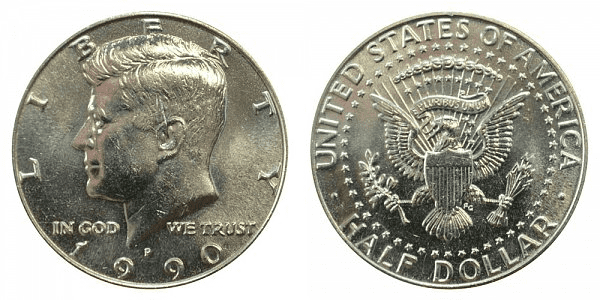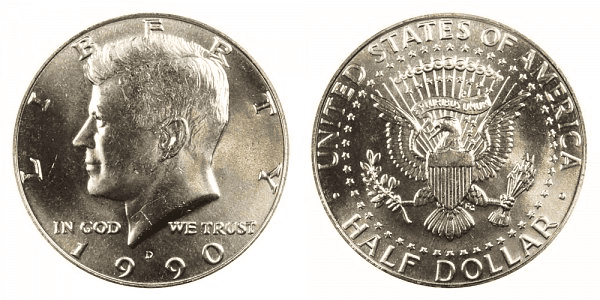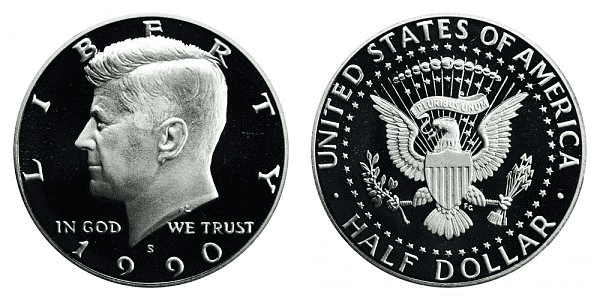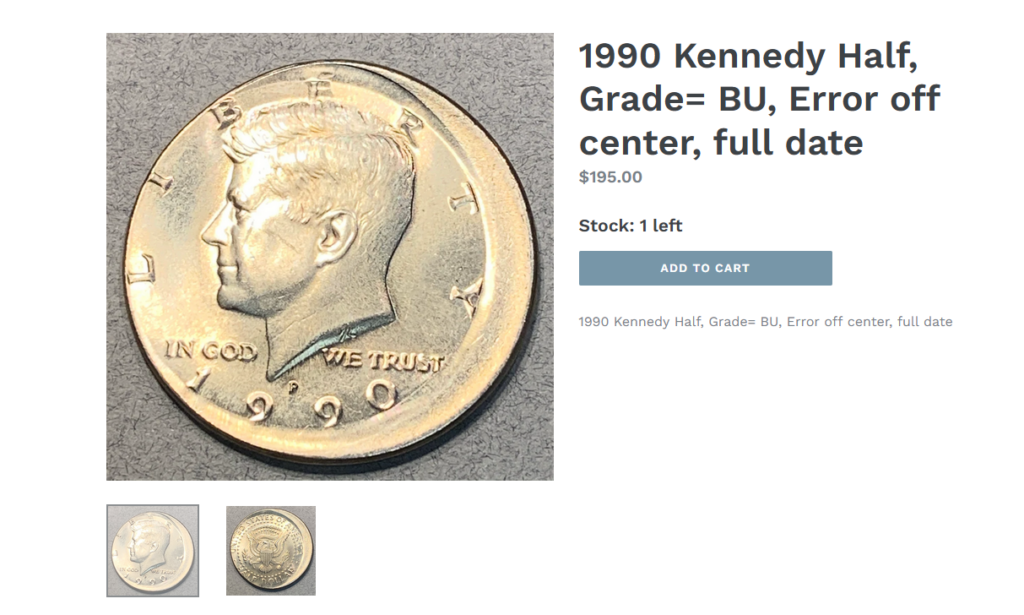What Is the 1990 Kennedy Half Dollar Made Of?
President John F. Kennedy was assassinated in Dallas, Texas, on November 22, 1963, prompting Congress to speedily approve the redesign of the half dollar in the nation’s memory.
In place of the Franklin half dollar, which had only been in circulation for 16 years (since 1948), the first Kennedy half dollar was introduced in early 1964.
The Gilroy Roberts-designed obverse and Frank Gasparro-designed reverse of the Kennedy half dollar were an instant success. Millions of Americans in mourning jumped at the chance to buy a “memorial” of Kennedy for just 50 cents. This caused many people to believe that the Kennedy half dollar is fundamentally more valuable or worthwhile of saving than the other half coins, which quickly contributed to the half dollar’s actual removal from circulation. Even while the half dollar was still included in the lineup of business-strike circulating currency until 2002, by the early 1980s, the denomination had all but disappeared from day-to-day transactions.
From 1970 onwards, all silver content was removed from the Kennedy Half Dollar, and a composition of 75% copper and 25% nickel was chosen – the same that was already being used for dimes and quarters. Because of this the 1990 Kennedy Half Dollar contains no precious metal and has a weight of 11.34g and a diameter of 30.6mm with a reeded edge.
The reunification of Germany, the Hubble Space Telescope’s launch, Nelson Mandela’s release from imprisonment, and Margaret Thatcher’s resignation are a few significant 1990 events. The Gulf War crisis started in this year as well, and in the fall, Tim Berners-Lee laid the groundwork for the World Wide Web by developing the first web server.
1990 Kennedy Half Dollar Varieties
1990 P Kennedy Half Dollar
Year: 1990
Face Value: $0.50
Composition: 75% silver and 25% copper
Mass: 11.34 grams
Diameter: 30.6 millimeters
Thickness: 2.15 millimeters
Edge: 150 Reeds
Minted in: Philadelphia
Mint Quantity: 22,278,000

1990 D Kennedy Half Dollar
Year: 1990
Face Value: $0.50
Composition: 75% silver and 25% copper
Mass: 11.34 grams
Diameter: 30.6 millimeters
Thickness: 2.15 millimeters
Edge: 150 Reeds
Minted in: Denver
Mint Quantity: 20,096,242

1990 S Kennedy Half Dollar Proof
Year: 1990
Face Value: $0.50
Composition: 75% silver and 25% copper
Mass: 11.34 grams
Diameter: 30.6 millimeters
Thickness: 2.15 millimeters
Edge: 150 Reeds
Minted in: Denver
Mint Quantity: 3,299,559

List Of 1990 Kennedy Half Dollar Errors

There are no widespread or highly sought after 1990 Kennedy Half Dollar errors out there, but it doesn’t mean the errors can’t be quite interesting in individual examples such as at the off-centre coin seen above or the struck through error seen below.

How Much Is the 1990 Kennedy Half Dollar Worth Today?
As of January 2023 the Kennedy Half Dollar has a melt value of only $0.1142191. The overall monetary value of this coin is pretty low as can be seen in the chart below:
| Coin | Grade | Value |
| 1990 P Kennedy Half Dollar | MS63 | $3.30 |
| 1990 D Kennedy Half Dollar | MS63 | $3.30 |
| 1990 S Kennedy Half Dollar Proof | PR65 | $6.65 |
How Does The Grading System Work?
The Sheldon Scale is used by numismatists to provide a numerical value to coins. The Sheldon Scale goes from poor (P-1) to perfect mint state (P-1) (MS-70). Coins were originally evaluated using words to reflect their condition (Good, Fair, Excellent, Etc.). Unfortunately, coin collectors and dealers had different ideas about what each of these terms represent.
Professional numismatists joined together in the 1970s and established coin grading standards. These numismatists now assign grades at key places on the seventy-point scale, using the most regularly utilized numeric points in conjunction with the original adjective grade. The following are the most common coin grades:
- (P-1) Poor – Indistinguishable and probably damaged; if used, must have a date and mintmark; otherwise, rather battered.
- (FR-2) Fair – Nearly smooth, but without the damage that a coin graded Poor often possesses. The coin must have enough detail to be identified.
- (G-4) Fair – Inscriptions have merged into the rims in some areas, and important elements have been mostly erased.
- (VG-8) Very Good- A little weathered, but all of the primary design elements are visible, albeit faintly. There is little if any, central detail left.
- (F-12) Good – The item is very worn, yet the wear is even, and the overall design details stand out clearly. Rims are almost completely isolated from the field.
- (VF-20) Very Fine – Moderately weathered, with some finer features still visible. The motto or all letters of LIBERTY are readable. Both sides of the coin have entire rims that are separated from the field.
- (EF-40) Extremely Fine – Gently used; all gadgets are visible, and the most important ones are bold. The finer details are bold and clear, however, light wear may be seen.
- (AU-50) Uncirculated – Slight evidence of wear on the coin’s design’s high points; may have contact marks; eye appeal should be adequate.
- (AU-58) Uncirculated Choice – Slight traces of wear, no severe contact marks, almost full mint shine, and great eye appeal.
- (MS-60) Mint State Basal – Strictly uncirculated; no indication of wear on the coin’s highest points, but an unsightly coin with reduced luster, visible contact marks, hairlines, and other flaws.
- (MS-63) Mint State Acceptable – Uncirculated, but with contact scratches and nicks, little reduced shine, but otherwise appealing appearance. The strike is weak to average.
- (MS-65) Mint State Choice – Uncirculated with great mint shine, very little contact blemishes, and exceptional eye appeal. The strike is unusually severe.
- (MS-68) Mint State Premium Quality – Uncirculated with superb luster, no obvious contact marks to the naked eye, and exceptional eye appeal. The strike is quick and appealing.
- (MS-69) Almost Perfect Mint State – Uncirculated with perfect brilliance, a sharp and appealing strike, and extremely good eye appeal. A near-perfect coin with minor imperfections in the planchet, strike, and contact markings (seen only under 8x magnification).
- (MS-70) Mint State Perfect – Under 8x magnification, there are no tiny imperfections discernible; the strike is crisp, and the coin is perfectly centered on a beautiful planchet. Rarely seen on a coin, this coin is bright and whole, with original luster and exceptional eye appeal.
Where To Buy Or Sell 1990 Kennedy Half Dollar?
As mentioned, there really aren’t any highly sought-after 1990 Kennedy Half Dollars, meaning that only those with the most obvious of errors are worth more than a few dollars. Due to the relatively recent (in terms of the history of coinage) release of the coin, you may even come across this coin in your pocket change, and these coins are common fayre at flea markets. When purchasing online, many sites offer these coins at affordable prices such as Golden Eagle Coins and even error coins at reasonable prices such as at Hyatt Coins.
FAQs
Is a 1990 Kennedy half dollar worth anything?
Outside of those in exceptional condition (which are only worth $3-7) and error variants (which tend to be worth between $10-100) there aren’t any Kennedy Half Dollars that are particularly valuable.
How rare is a 1990 half dollar coin?
Due to how modern the coins are and how many were produced, the 1990 half dollar is still a pretty easy-to-find coin.
Is a 1990 half dollar silver?
There’s no silver content in a 1990 half dollar. The half dollar hasn’t had any silver in it since 1969.
